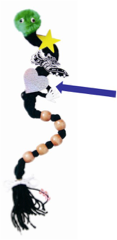Secure Checkout + FREE SHIPPING (U.S. Orders over $60)
Menu
-
- Home
-
About Us
-
The Approach
-
Linking Language & Literacy
-
Professional Learning
-
Learning Resources
-
SHOP
-
Blog
-
- About MindWing
- Our People
- Contact Us
- Your Account
- Login
-
United States (USD $)

Secure Checkout + FREE SHIPPING (U.S. Orders over $60)
Part 3: Feelings, Perspective Taking, Theory of Mind, Empathy and Mr. Hatch!
by Sheila Zagula April 17, 2015 4 min read
Our last blog focused on Mr. Hatch’s feelings in response to three separate kick-offs ![]() from Somebody Loves You, Mr. Hatch.
from Somebody Loves You, Mr. Hatch.
We used the new Feelings/Kick-Off Map (below) and looked at the back of the Feelings mini-poster for an additional activity that would lend itself to a center activity. Our goal is to develop an understanding of the relationship between the kick-off and feelings of characters that ultimately leads to an awareness of the critical thinking triangle, which motivates the actions of characters. Today, we will expand on our feelings activities.

Central to Mindwing’s teaching strategies is the connection between the developmental stages of narrative development and their relationship to expository text structures.

Children’s literature may be used at each stage to gradually guide students through each narrative step to the next developmental stage. These stages have been well documented and form the basis of our methodology. Narrative developmental stages have been researched and explicitly described: Applebee, 1978; Wallach and Butler, 1994; Lahey, 1988; Langdon and Cheng, 1992; Merritt and Liles, 1987; Owens, 1991; Roth and Spekman, 1986; Stein and Glen, 1979; Stein and Policastro, 1984; Westby, 1985, 1989. As students progress along this continuum, they encounter information in many forms of both narrative and expository structures and they are expected to organize and express this information. Using the SGM icons scaffolds this process for students.
Below find the recently created FEELINGS, COMPARE AND CONTRAST Map.

Notice on the map that the academic vocabulary word perspective is used. Up until this point, you may have been using terms such as “point of view” or “from the way Mr. Hatch felt.” Now is a good time to begin to use the word perspective in your lessons and discussions.
Share the map with the students. Fill out the top portion of the map with the students as shown.

 Use your teacher marker and point to the icons on it to discuss how Mr. Hatch felt
Use your teacher marker and point to the icons on it to discuss how Mr. Hatch felt 
So, we have reinforced the concepts that one event can lead to many feelings and that we may experience some of the same feelings in response to two very different kick offs. We have added the element of the expository skill of compare/contrast and of course, a list. All along, we have been identifying, discussing and naming feelings.
Now, you may use this versatile map to show this idea but from two different characters’ perspectives experiencing the same kick-off. In this case, we will use Mr. Hatch and Mr. Goober, the mailman.
For our purposes in this book, the kick-off will be when Mr. Goober returns for the package. Fill out the top portion of the map with the students.

Review the text and pictures from the book. And have students use their feelings mini-posters to brainstorm with partners how the characters felt. Make a list of the feeling words chosen.
Examples: Mr. Hatch: hurt, disappointed rejected. Both: upset, sad, empathetic (MR. Hatch, not wanting the mailman to get into trouble with his supervisors and Mr. Goober not wanting take the package back from Mr. Hatch and hurt his feelings) Mr. Goober: embarrassed, guilty, sorry.
Then organize the list (again pointing out to students that it is a list, an expository structure itself) on the Compare/Contrast Feelings Map.

Note how we used the word empathetic which is more than likely a new academic vocabulary word for the students… we not only are using the words but explaining WHY we have chosen certain words from the poster to describe the feelings.
In today’s blog, we have added another dimension: That characters can experience the same kick-off and share the same feelings or have different ones, depending on their perspective.
Enjoy using this new Compare/Contrast Feelings Map with your students with other books as well. Join us for our last installment of this feelings blog next week!
Click here to download blank Maps for this Mr. Hatch lesson!
Leave a comment.
Comments will be approved before showing up.
